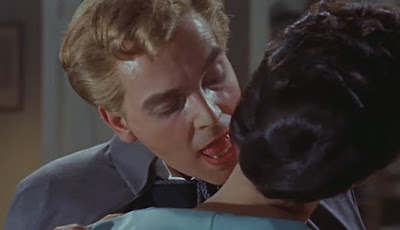1960s
James Bond triple bill
So, from the exciting introduction to the Bond universe that Dr No provided, I moved along (chronologically, of course) to a trio of films that pretty much embody what James Bond is. These films are the very peak of ‘Bond-ness’, they’re so jam packed with all the exciting (and ridiculous) tropes that came to define the the Bond film as a series that it’s no surprise that Austin Powers found the vast majority of its material here - some of the scenes are almost shot-for-shot identical!

From Russia With Love (1963 / Terrence Young / Sean Connery)
Goldfinger (1964 / Guy Hamilton / Sean Connery)
Thunderball (1965 / Terrence Young / Sean Connery)
Both From Russia With Love and Thunderball feature Spectre plots for our heroic agent to battle, whilst Goldfinger is much more of a one-man villain. From Russia takes us from the early form of Dr No and ramps it up by throwing a whole lot more excitement at it. Bond now has some serious gadgetry (albeit relatively basic) and his quick-assembly sniper rifle is particularly useful. We also meet some of the most fabulously English of scenes - the foreign spy on the train who gives himself away by drinking red wine with fish! What a mistake! Sean Connery, as ever, is fabulous throughout but I couldn’t help feeling that, whilst From Russia threw an awful lot of exciting elements at the plot, the structure of the story itself was slightly lacklustre. Like Dr No, it had it’s peaks and a few very memorable moments but as a film it was certainly lacking something.
Goldfinger, easily one of the very best of Bond, takes all the elements that From Russia contained and turned them up a bit. Rosa Klebb’s killer shoe becomes Oddjob’s killer hat, a comparatively timid attempt to steal a code-machine becomes an audacious plot to irradiate all of America’s gold, etc. etc. Goldfinger turns the heat up - and possibly overdoes it. Here then, we find lasers! gadget cars! sprayed gas! an implausibly strong Korean! and all sorts of other madness.
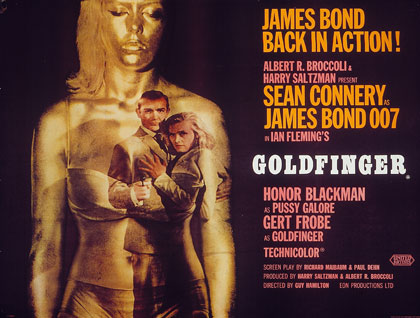
I’d call it a film of hits and misses: when it gets it right, it gets it very right indeed… but occasionally it’s not quite so strong. A prefect example of the latter would be the extended Bond vs. Goldfinger golf showdown. I’ll repeat that: golf. I mean, whoever thought to set a dramatic encounter over a (long) game of golf? When we’ve been teased with bullet-proof cars and tear-gas briefcases, an elaborate ball-swapping plot that centres on Bond’s recognition of the Slazenger 5 golf ball is… boring.
That said, some of the scenes are undeniable classics. The sight of Bond, strapped to a chunk of metal with a high-power metal-cutting laser edging ever closer towards painful emasculation is as unforgettable as James Bond films get. It would be sublime even without dialogue but the now classic exchange “Do you expect me to talk / No Mr Bond, I expect you to die” is so wonderfully blunt that it just makes the scene perfect.
The only thing, to my mind, that really stands in the way of Goldfinger being the absolutely perfect Bond film is the utterly ridiculous names used throughout. So Goldfinger likes gold? And his first name is Auric? Like the element? And his odd job man is er… called OddJob? And the major plan to contaminate Fort Knox is called Operation GrandSlam? And the sex-interest woman is called Pussy Galore? All this and more: Goldfinger is about as subtle as a sledgehammer. Whilst I’d never demand a thoughtful or challenging Bond film, Goldfinger does occasionally feel like it’s treating us like idiots. I had absolutely understood that the sexy woman would have sex with Bond without her being named Pussy Galore (suitably mocked by Austin Powers’ Alotta Fagina). It’s, sadly, the kind of choice that makes this film feel so dated - even more than its two predecessors.

The last time I saw Thunderball - where we’re back with Spectre and have a plot of nuclear-ransom - was before the Austin Powers films; it’s hard to watch it in the same way now. We get scenes in the Spectre lair with ’number one’ frying his cheating agents (whose steaming, but now empty, chairs return to the table), an eye-patched villain and a fantastic opening scene with a Spectre agent dressed as a grieving widow. Bond doesn’t actually shout “That’s a man, maaaaan!” but I could here it in my head…
As a film Thunderball is the most coherent and elaborately plotted yet but (for all that I teased Goldfinger) it lacks some of the more outrageous fun. There’s no decent villain - eyepatch man does little besides giving grumpy orders - but there are some decent scenes (chase scene through the carnival!) and it does hang together as a pretty decent film. Sadly, there are far too many dull action sequences for it to be a true classic… Underwater scenes galore here and none of them are much fun. Some stirring music isn’t enough to save a long, slow, flippers-and-wetsuits harpoon-battle snooze of a scene in what ought to be the most exciting part of the film.
Despite some flaws in each, these three Bond films are a pretty exciting triple-bill of action fun and, taking over where Dr No left off, make a convincing case for crowning Sean Connery as best Bond ever. From here, there’s only one more Connery-Bond left before we come to George Lazenby’s disasterous effort…
Watching James Bond films. All of them. In order.
So… this week I’ve taken on a new and exciting challenge: I’m going to watch all the James Bond films, ever single one, in the order they were made. Now, I’m not a complete masochist so I’m not going to set any kind of time limit on this: I’m not watching all 22 (twenty two!) back-to-back! I’ll take it nice and slow; I’ll put on the tux, shake my vodka martini and then relax and watch Bond, SPECTRE and all manner of exciting things.
Dr. No (1962 / Terence Young / Sean Connery)

And what better place to start than at the beginning? Dr. No, the film that started it all, is still a decent litle thriller by today’s standards. It’s packed to the brim with awesome and very memorable moments - Ursula Andress emerging from the sea! - and it cracks along at a decent pace, with attempted spider-aided assassination, fist-fights and car-chases. It doesn’t have some of the classic elements we came to associate with later Bond films - gadgetry is decidedly thin here - but it does a lot of what you’d expect from a Bond film and does it well.
Sean Connery lays down a serious argument for his place as Best Bond Ever with his brilliantly suave performance, whether flirting in the casino or punching SPECTRE agents in the head - leaving the bloodied, dead agent in the car for the valet to deal with! There’s no evil henchman on show (although sometimes that’s a good thing) but Dr. No himself with his EVIL METAL HANDS is charismatically evil, a perfect villain.
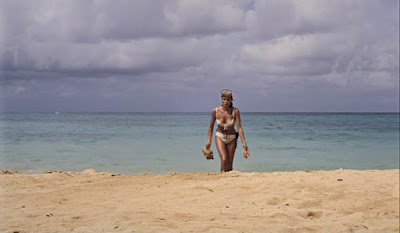
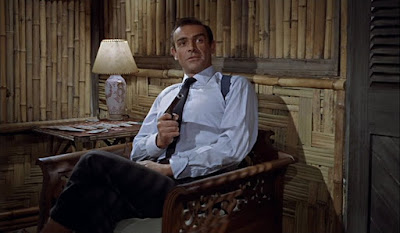
The unavoidable criticism of the film, sadly, is that the ending just isn’t very good. After such a decent story and some brilliant scenes, Bond and Dr. No’s fight in what appears to be a climbing frame over the er… yellow-lit toxic bubbling water of death is really pretty lacklustre. Having built him up as a booming-voiced overseer, a metal-clawed monster, a smooth-talking SPECTRE agent, Dr. No’s ignoble exit into the - oh so terrifying! - bubbling water is a complete let down really. Still, at least they make up for it a bit by blowing up the base… We all like a good explosion!
It’s a good film, great fun to watch and, in many respects, just what you want from a James Bond film. But it’s not perfect. Right, on with the list…. From Russia With Love next.

Hammer Horror - Dracula and Brides of Dracula
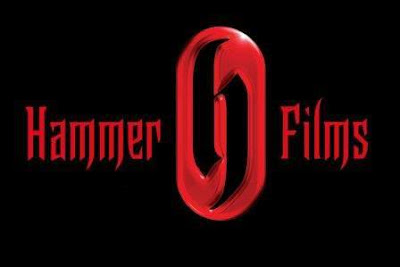
Part of the aim of writing this blog and of taking more notice of what I watch, is to improve my general film knowledge and to encourage me to fill in some of the gaps - whole genres and famous names that I know little or nothing about.
Sometime of course, fishing about in new genres just isn’t appealing and I’ll settle back into the safety of the Spaghetti Western or a predictably nonsense ‘horror’ film - like Attack of the Killer Shrews. Recent viewing however has seen me beginning to get to grips with classic American Film Noir (about which I’m sure I’ll write something soon) and, for this post, the wonderful world of Hammer Horror.
I’m not quite sure how on earth I’d gone for so long with very little awareness of Hammer’s output. As a firm fan of both Christopher Lee and Peter Cushing, with a fondness for slighly camp British horror of the last few decades, how had I never really become a Hammer fan?
Thankfully, I am now very much a Hammer fan. I bought A New Heritage of Horror by David Pirie (I.B.Tauris, £15) which, however much he tries to deny it in his introduction, is basically a history of Hammer’s film output. And none the worse for it. Much as my love of Zombie films was gently lead and guided by Jamie Russell’s Book of the Dead (Fab Press, £11), I found myself flicking through this book with a growing list of scribbled down “must-see” titles.
I started with X: The Unknown (radioactive slime crawls out from the centre of the planet and munches its way through some tasty radioactive things), Hound of the Baskevilles (Good fun adaptation) and The Devil Rides Out - which I enjoyed a lot and might have to re-watch and review)
My now fairly strong feeling that I was onto something rather wonderful was confirmed when I moved onto the Dracula series. So let’s start at the beginning shall we?
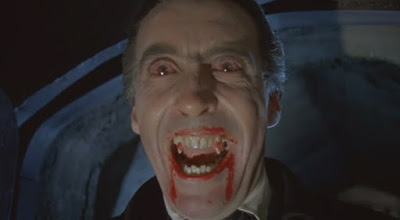
Hammer’s 1958 version of Dracula is brilliant. THere are flaws a plenty but I think it’d be hard not to enjoy the film. It’s well-paced, ever-so British and it has Christopher Lee draining the blood from those around him. What’s not to like?
It was one of Hammer’s first widescreen and colour production and really does look beautiful - although the colour of the blood is decidedly more akin to strawberry than it perhaps should be. Though obviously not being produced on a massive budget, the sets are wonderful, Dracula’s Transylvanian castle is as real as you could hope for and the whole film carries its gothic mood wonderfully.
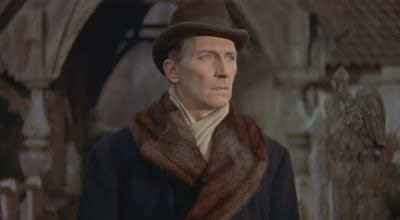
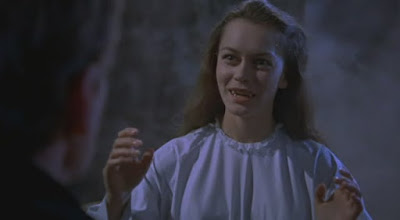
Budget constraints did force them to savage the plot somewhat (Johnathon Harker’s family now live er… right near the castle) and many elelments are missing but this doesn’t particularly hurt the film in itself. Whilst it might suffer in comparison to the novel, the story that remains is strong enough and moves along at a decent pace, aided no doubt by some brilliant acting. Christopher Lee is a perfect Dracula; just the right balance of menace, charm and pointy-teeth, whilst Cushing is brilliant in the somewhat more understated part of Van Helsing.
The film was one of Hammer’s biggest successes and sold well the world over….
….So they made some more.
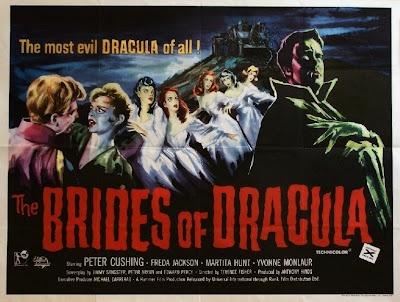
Needless to say, Hammer quickly realised that having Dracula destroyed at the end of the first film wasn’t really the smartest move - they needed more vampire and they needed it now! Similarly awkward was Christopher Lee’s absence; David Pirie writes that it’s unknown whether he flat-out refused or asked for more money than Hammer could spend. Either way, he wasn’t coming back. So neither was Dracula.
Infact, the follow-up to Dracula, 1960’s The Brides of Dracula is pretty surprising as a Dracula film for er…. not having Dracula in it.
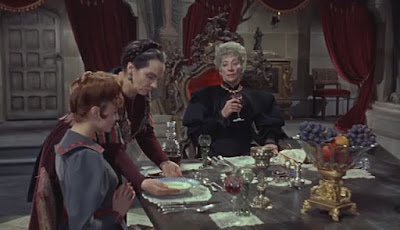
It’s still pretty good fun; Cushing returns as Van Helsing who really does just happen to be in the right place at the right time all over again and is on hand to help stop the rise of the Baron Meinster who has escaped from his perpetual confinement and has gone on a bit of a rampage, sinking his teeth into the necks of the women he meets.
It’s another good fun film, although there’s decidedly less tension to it - despite the fact that I didn’t already know the story, this Baron was so much less charismatic, so much less calm and cool, that I really did struggle to imagine him winning. Needless to say, he doesn’t.
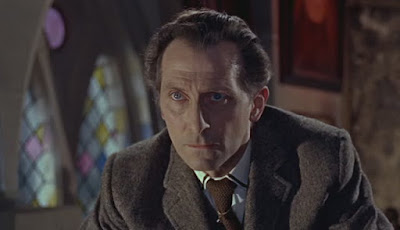
What it loses in tension and atmosphere -especially in the second half - however, it does mostly make up for by being generally a lot of fun. And we like fun films, right?
Of course we do.
